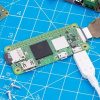After defining voltage in last week's T³ video, it's time to talk about current. Electric current is the flow of electric charge, and for most circuits, this is carried out by moving electrons in a wire or other electronic component.
We can measure current by looking at the amount of charge moving past a point (such as in a wire) per unit of time. The SI unit for electric current is the ampere (A), which is coulombs per second (C/s). Note that electrons are generally the charge carrier in a circuit, and they move from lower potential to higher potential. "Conventional current," however, is a measure of positive charge moving in a circuit that moves from higher potential to lower potential, and it moves in the direction opposite of electron flow. We can thank Mr. Ben Franklin for that bit of confusion.
For those of you already familiar with these concepts, I must ask once again for your feedback: What worked, and what would you have done differently? As we make more of these concept videos and tutorials, they will be featured on our education site for teachers, parents and students to freely use and study.
Much of the video was information taken from our "What is a circuit?" written tutorial:
What is a Circuit?
February 6, 2013
Every electrical project starts with a circuit. Don't know what a circuit is? We're here to help.
Interested in learning more foundational topics?
See our Engineering Essentials page for a full list of cornerstone topics surrounding electrical engineering.









Overall great video. You have a good explanation describing the movement of electrons in a conductor and the conflicting direction conventions. What I would have done differently is after using the word 'most' to qualify several statements, mention what exists in addition to electron flow. Current is the sum of all effects of electron, ion, proton, and hole flows. For an introductory video you wouldn't need to go into detail other than referring the viewer to the battery or semiconductor video to get more of the story.
Thanks, and that's a really good point. I left out the fact that ions can be charge carriers, as it didn't seem pertinent to most electronic circuits. However, just pointing the viewers to the battery video would be helpful.